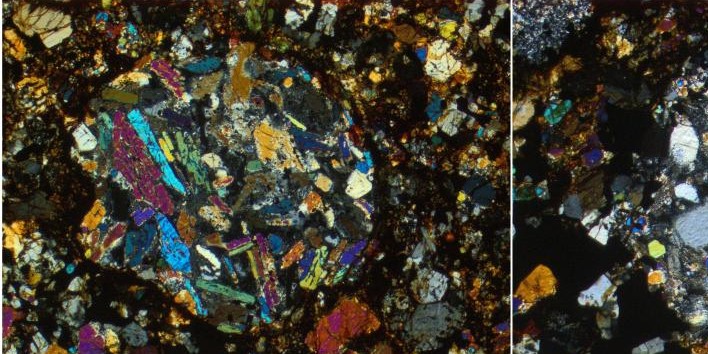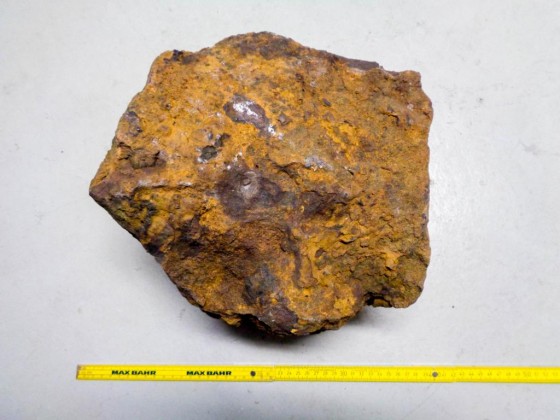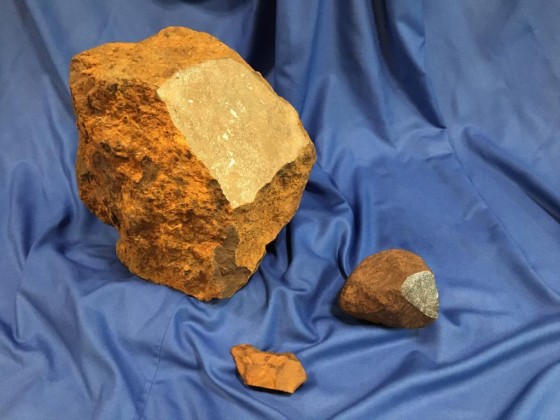
Largest stony meteorite of Germany found
Even in science, chance sometimes produces more thrilling discoveries that the most ambitious plans. In 1989, a homeowner was digging a cable trench on his property in Blaubeuren, in the German region of Swabia, when his spade hit a rock measuring 28 by 25 by 20 centimetres. Upon lifting it half a metre to the surface, he found that it was remarkably heavy. He held a magnet to the rock and confirmed that it contained iron. The angular boulder was then left lying in the garden for decades. Only 31 years later did it occur to the finder that it might be a visitor from space. In January 2020, he reported his find to the Institute of Planetary Research at the German Aerospace Centre (Deutsches Zentrum für Luft- und Raumfahrt; DLR). Then, after the first scientific analyses, came the sensational discovery that the object is indeed a stony meteorite. In addition, with a mass of over 30 kilograms, it is the largest ever found in Germany. On 7 July 2020, the Meteoritical Society, the international organisation of meteorite researchers, which documents all meteorite finds and falls worldwide, confirmed in its bulletin that this find had been recognised as a meteorite. It has been officially named 'Blaubeuren' after the place where it was discovered, the small medieval town of Blaubeuren, 17 kilometres west of Ulm.
"This is a standard type H4-5 chondrite," says Dieter Heinlein, a meteorite expert at the DLR Institute of Planetary Research in Augsburg and coordinator of DLR's research into and studies of 'Blaubeuren'. "The find has a mass of 30.26 kilograms, making it the largest stony meteorite ever to be found in Germany." Prior to 'Blaubeuren', the 'Benthullen' meteorite, which was discovered near Oldenburg, was the record-holder, with a mass of 17.25 kilograms. The density of 'Blaubeuren' has been determined to be 3.34 grams per cubic centimetre; this is particularly high due to the meteorite’s significant iron and nickel content.
Researchers at the Institute of Planetology at the University of Münster prepared thin sections of the stone in order to determine the chemical, mineralogical and petrological composition of the object. "'Blaubeuren' is obviously a breccia, in other words a rock that has been created by the agglomeration of a number of fragments," explains Addi Bischoff from Münster University. “In the past, the Blaubeuren meteorite experienced at least one violent collision. We often see this with H4 and H5 chondrites." Under the surface lies the iron and magnesium silicate olivine, which makes up almost three quarters of the mineralogical constituents of the meteorite.
The story in detail – a series of coincidences

The meteorite languished in the landowner's garden until 2015 and became increasingly weathered over time. At that point, he almost got rid of it altogether, saying: "The boulder was actually on the trailer, ready to be taken away." Fortunately, he had second thoughts and transferred the rock to his cellar, where it was kept safe and dry in a cupboard. In January 2020, he decided to find out about the composition and background of this strange rock once and for all, and contacted DLR. Heike Rauer, Director of the DLR Institute of Planetary Research, and Jürgen Oberst, who oversees the European Fireball Network at DLR, put the finder in contact with Dieter Heinlein, DLR's meteorite expert in Augsburg. The Institute maintains a website with information and a checklist for identifying potential meteorites, plus an address for reporting meteorite sightings.
The cut fragment that revealed the secret of 'Blaubeuren'
After a discussion on the phone and the sending of numerous images, the finder sent a fragment weighing 23.4 grams to Heinlein. From a visual inspection, the expert could immediately recognise the presence of iron ore, but when he reached for his diamond saw and cut the small piece open, he was utterly amazed. Heinlein saw a matrix of millimetre-sized chondrules that is typical of stony meteorites. These small spheres were created during the formation of the Solar System 4.5 billion years ago and represent the original building blocks of all the planets. He also discovered the characteristic metal inclusions of a meteorite. "I was immediately pretty certain that this was a fragment from a meteorite," says the DLR expert.
On 9 February 2020, the finder entrusted the main part of the meteorite to DLR for further investigations, including a precise determination of the density of the material. A while later, another fragment weighing 410 grams was found in the same garden. This additional find was also subjected to intensive scientific investigation. In consultation with the finder, the main body, which weighed over 30 kilograms and was heavily weathered on the outside, was cut into in order to examine the chondritic structure of the meteorite and its inclusions in greater detail. Even Heinlein, who has a large collection of specialist tools, was somewhat overwhelmed: "Of course, I had never had such a large piece of rock in my laboratory." He found a specialist company to help – the workshop of the stonemason and sculptor Peter Fraefel in Mindelheim, Allgäu. On 30 May 2020, after intensive planning and preliminary discussions, a 576-gram corner of the meteorite was removed using a diamond saw.
A journey through three laboratories – 'Blaubeuren' analysed

In a laboratory at Radiation Protection, Analytics & Disposal (VKTA), Detlev Degering conducted measurements of the radioisotope content in the main meteorite mass and the subsequent find, and also analysed soil samples from the garden where they were discovered. This enabled the proportions of the cosmogenic, terrestrial and anthropogenic (i.e. human-caused) radioisotope components to be determined. The aim is to find out roughly when the meteorite fell to Earth. Judging by its weathering, this could have happened several centuries ago. Investigations in this area are still ongoing.
After the meteorite was finally examined for its chemical, mineralogical and petrological composition at the Institute of Planetology at Münster University and the researchers determined that it was the result of a cosmic collision, Kerstin Klemm submitted "Blaubeuren" to the Meteoritical Society's Nomenclature Committee on 16 June – only three weeks later it was recognized as a meteorite.
For now, Blaubeuren will remain with its finder, but ultimately the owner wishes Germany's largest stony meteorite to be on permanent display in a museum, so that the public will also be able to marvel at this 'Swabian that fell from the sky'.
Background to meteorites on Earth
Meteorites play a hugely important role in the study of the early development of the Solar System. They arrive on Earth of their own volition and 'free of charge'. Most of them originate in the asteroid belt between Mars and Jupiter before their orbit is disrupted, putting them on a collision course with Earth. They enter the atmosphere at high speed so, even if they were originally large masses of rock or iron, often only a small remnant actually hits Earth as a meteorite.
